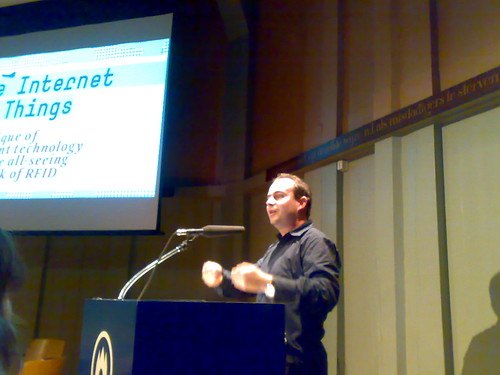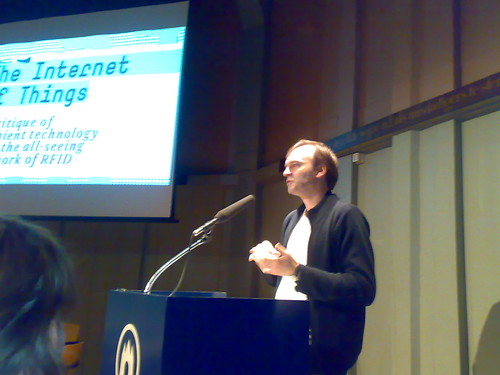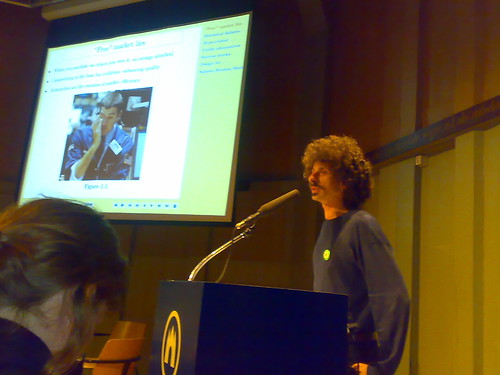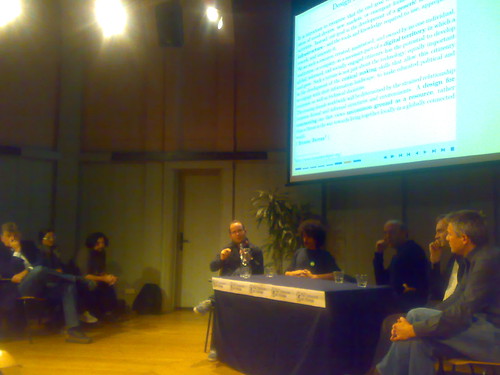Internet of things book presentation at the Waag
Internet of things book presentation by Rob van Kranenburg.
28th of october, Theatrum Anatomicum, the Waag, Amsterdam
intro by Geert Lovink (INC).
The full publication can be found here (thanks jaromil for bringing this to my attention)
(a camera is recording all this, so why blog, right? (must be the habit). Find it via www.waag.org.)
Introduction
We are treated with a visual intro of the book by Rob van Kranenburg.
The intro is given by Geert Lovink – Director of INC, that published the book. The INC is a part of the HVA, which is currently called “university of applied sciences” (so that you know…).
This afternoon will consist of a few short speeches that will act as input or at least contributions to a discussion. They will contain talks about the book and the ideas Rob has put into this publication.
In the narrow sense it is a ” RFID debate”. Luckily, Rob has broadened the subject. He looked into the social side of RFID and an internet of things, as well as interventions dealing with this internet of things.
About the Institute of Network Cultures
The INC facilitates interactions between people and communities online – bringing together these clouds in order to summarize what is going on. In a time where technologies are becoming smaller, their impact is becoming bigger and their production is faster, the question is; where are we? Can we discuss these things? We would like to contribute to the public debate. We are looking for writers. ( Is this actually a call for publications?)
About the book
It is important that we more carefully research what is going on. Technologies of control are getting more pervasive. What to do as an activist? While discussing and dismissing these technologies, at the-same time the-same people (activists) are using these technologies for their own use. Technology as such is a force, where different (sub) forces and domains are active within certain technological fields. We have to experiment with it ; this is the paradox Rob talks about in his book. Rob has tried to capture these ambivalent feelings. Within the pubic debate, we want to remain researching this collective ambivalence. Social movements these days are swift and change fast: we cannot be naive anymore; we do not want to put ourselves outside. The floor is Rob’s:
Rob:
I want to be brief; thanks INC. As I experience being online, it still is a nice thing to have a book. It makes things tangible. Thanks Sean for commenting, forwording, and being a friend.
It is difficult to produce text; lots of version I have written – it is a hard process. The image of two cities gave phasing into complex things. This radicalizing (into cities of control vs cities of trust resp.) helped in sorting the story out. Still, it was extremely difficult, because one can slip into all kinds of modes. From a journalist to a poet (where the latter is always more right than the first).
Still, I want to stress that we have to keep things ambivalent. Technologies have the tendency, or already have taken out all the messiness we have in life. If we keep thinking that way (the modernistic way; that of producible man) our world not work; we need messyness.
I found three good friends who are going to speak about the book. (Eric Kluitenberg, Jaromil and Martijn de Waal)
There is an Amsterdam- thing going on about these hybrid spaces; This book of mine is an essay as well as it is an open platform to join and jump in. The goal is to get some practice going; because that is what it is all about.
Martijn de Waal.

Organized “The Mobile City” conference and has started a blog about the mobile city. With the arrival of hybrid spaces, there is an architecture approach to the things Rob talks about. De Waal quotes Lovink, who has ones mentioned a critique on Internet Research; they are only describing. The goal is not to describe but shape it (the internet in this case). We need critical concepts that can be implemented . What kind of technology can be used in order to become influential in the debate? De Waal has searched for these concepts in the book and has come up with two main points:
1) We need not seamless, but seamfull design .
Where technologies are disappearing, the company view on the matter is that it is about seamingless-ness without you noticing it.
This is not the fact. He quotes Bill Gates in 2004 “due to the continued growth of computational power we can crate any device possible:
it is the software that will magically tie stuff together” This is only mystifying technology; we should divert from this.
We need a much more seamfull approach; you should make technology more visible; more accessible:
There are some problematic things with seamingless-ness:
1) you cannot fix technologies when they break down; you need external help (‘a certified magician’)
2) if technology becomes invisible, it means the affordances of this technology are hidden.
Now it becomes harder to tinker with it. (skype phone example).
3): if you cannot only fix own car: you have lost a belief in social initiatives and the notion that once you could. This can cultural consequences; people become dumb; they forget the potential of technology.
2) City of Control vs City of Trust
This is a concept to describe the future of technology in a urban situation and is mostly used in debates about tracking and tracing. Where all kinds of informational systems are melting into a giant database; or at least multiple databases, you can no longer escape. The people that say they do not care about their data are missing one point; this argument cannot hold because data is stored longer than legislation. What is normal today may be prohibited in the future; a dystopian scenario.
The concept of city of trust is the same. The same technology is here, but it is designed in a different way. Instead of binary privacy, you have privacies. The user has control about technology and what he is doing. He decides what data he or she will share with whom in a Creative commons-like manner.
Erik Kluitenberg

Gives a reflection on the book by first reflecting on Rob:
“I really witnessed Rob’s growing expertise in this field over the years: within EU- fora about the disappearing computers to discussions about invisibility versus commitment.
And after that an shear RFID obsession. Now he is strongly involved in RFID projects.”
Since the OV chipcard trouble in Holland lots of politics are getting involved.It is rally becoming a control issues right now; it is still problematic. The question is whether and how we can stop this technology? It is all about control these days- we have to deal with it. – regulations for this field are badly necessary. Where and how can we discuss this?.
Another thing is the interface question: Rob discusses this on page 23 of the book by asking “If the environment becomes the interface, where are the knobs?” How is the interface going to take shape, where most computing in this space is invisible. Erik wonders about the fact that new , 2.0 models of “user involvement” and “content on the Web” are still not really there. When looking at the ‘hot’ trend of the iPhone, the strange thing is that it is works on the ‘old’ model of technology. The iPhone is just a pile of old concepts – why is it so hot? Curious is that it is a screen-based interface on an established OS. It is documented. Lots of open-source ways to get in. Intelligence not in the network, but still in the device itself. Way before the app store came out , hackers had already created app stores by breaking open the iPhone. Why? Because the device was still there, so that it remains possible to design alternatives.
Within an internet of things, you do not carry the device anymore; the functionality is in the environment,. Obviously, we are not there yet. The interface challenge is a large one. The point to make is that we have to rethink that interface question. How do we intervene in current interfaces? Do we need a regulation for spaces? It is all about design and experiences of these things. Interface design needs a new input here, because there are deeper technological questions to address (than privacy resp.).
Jaromil:

Starts by talking about free market lies. (i was getting tired here, if anyone can fill me in, please do)
The first is that there is one market rule: When you purchase something, you own it.
The fact is that you don’t own the code of your phone, you don’t even own the phone anymore.
The second one is that competition is the motor for free markets
…Competition is not the motor for capitalism due to ….
The third is that monopolies are bad for markets:
…Something with open source being more slow, but more rigid- argument…
He continues by listing some historical failures:
– DRM (which is Digital Rights Management; a way too-late attempt by companies to still make money out of a lost race…)
Especially in gaming this has failed.
– fear-based society. Where people can call numbers if they see something scary.
We are told too many lies and do not believe that much anymore.
– equal opportunities.
Also failed. Even within the EU, there are still castes ( in Italy for instance) that decide politics and chances.
– Democracy and education.
This historical failure we are going to witness. iI we can invade all these privacies of people it will go wrong; there is no democracy without privacy.
We tried things like IP rights and creative industries. This did not work, either.
Also, we tried something called “Corporate service providers”.
One example of this not working is “the irate bay”. It is now said that they should redistribute wealth (the money they make via adds) from a central point –
the pirate bay community that gives back to the content producers. Apparently, we still like the old pattern.
Semi-public research funds was also a hypocritical attempt. Examples can be found in recent augmented reality spinoffs.
Corporate responsibility and finally philanthropic bubbles are debunked by Jaromil.
Luckily for us, he also comes up with viable alternatives:
– empowered content producers
– peer to peer services
– local ownership of production means
– more how-to, less manifesto
Some success stories of these models are mentioned:
– tv repair shops
– free voip technology
– Micro breweries
– Free Software
He finishes with a “design for commoning” manifesto (too fast to blog).
A panel discussion:

Geert:
In Germany there is a very strong, dynamic movement of activists against these technologies of control. In Holland, we have a more debacle – let-the- catastrophe- come strategy
We’ll see what happens, often too late. This is a question of social events occurring. Questions of agency and strategies (tactical or not).
Are these small events enough? Can they scale up? Or is it too early? Or should we wait until the catastrophe to unfold.
Think of free software; that took 25 years to develop. Can ideas be too young?
Rob:
Erik said that technology is a real force now – when you read Heidegger he says that you can only wait. Protest against the catastrophical line of the Chipcard is not helping anyone;
it is by default unhackable. You cannot hack all your groceries every morning. The polder model can help here.
The notion of an open infrastructure with RFID is completely tied to the internet. (Thats not really open, right?).
I need some form of oversight in order just to keep my own sanity – I was born thinking that anything can talk to anything. Now it will become reality.
The crash-scenario is that if we keep outsourcing our intelligence, the question of stability is rising. What if it breaks? Then, I think I would like to have my own network.
Then we can really use the expertise of people that are living in a distributing uncertainty. They are much more equipped.
Another question is: If it (IoT) will be there, for how long?
Martijn:
technology is not too young ; the technology is already implemented. It can be practical I the design of technology, plurality is needed.
Who is doing what with my data? How are we altering the parameters for design?
Jaromil:
There is no technology that is per se evil . We need new principles.
Audience: one way of describing pervasive technology: a totalitarian state of comfort.
The death of our society is coming. We try to avoid the crash.. What do we do when we switch off the light.
Jaromi:
What about regulation? I do not think regulation can do anything. Market lies lead to trouble and there was regulation there? What do you mean (q to erik?)
Erik:
Some ideas on this: the regulated market does not exist. People get informed about RFID via these discussions about regulation. The role of civil groups is to have interventions.
The other thing is the role of artists and designers; we have to make alternative scenarios and interfaces. How do these things influence our spaces.
Audience:
This RFID gets bigger and bigger; I want to talk technology for now… How much does it cost? How can it be hacked?
response by audience: lots of different types of rfid; passive and active. passive RFID by a reader.
Rob :
We have to open up the spectrum of technologies; from barcodes to bluetooth: we have multiple technologies.
Scenarios in their databases; things becomes data.
(example of reader in supermarkets and a fanta in the cola space)
Rob continues by talking about the platform in one space in Holland about RFID and other IoT technologies.
We will build this matrix – we have to get the designers in the right place…
Jaromi:
We want to map stuff; Objectively, we cannot trace anyone, this will create false positives.
Geert :
We have to wrap up: thanks all for being here; asks rob to do the ritual: inviting people for a drink by cutting a lint.
If you are interested in reading the book, send a mail to the institute of Network Cultures in Amsterdam